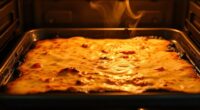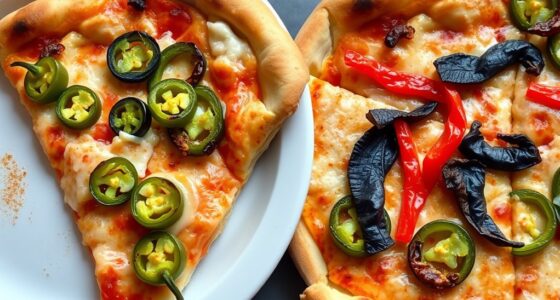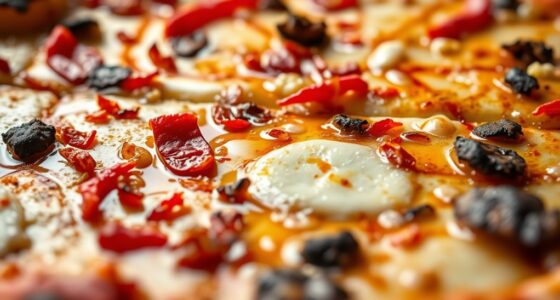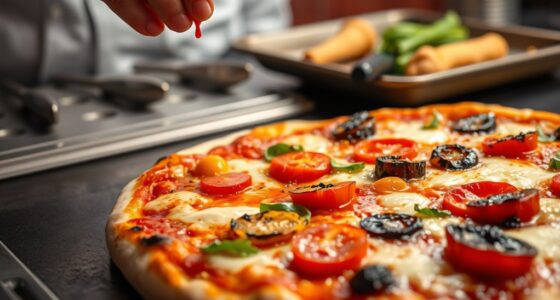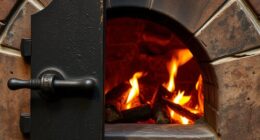When cheese burns or pools, choosing the right type is key. Use high-moisture cheeses like mozzarella or young cheddar for smooth melting and even texture, while low-moisture options like Parmesan may crumble or become greasy. Controlling the heat and stirring often helps prevent issues. Mixing different cheeses can improve melting, too. By understanding each cheese’s properties, you’ll get better results—and there’s more to discover on how to optimize your cheese dishes.
Key Takeaways
- Select high-moisture cheeses like mozzarella or young cheddar for smooth, even melting without pooling.
- Avoid low-moisture, aged cheeses such as Parmesan, which tend to crumble or become oily when heated.
- Use gentle, consistent heat and stir frequently to prevent burning and uneven melting.
- Combine cheeses with different melting properties to improve stability and prevent pooling.
- Understand each cheese’s melting behavior to choose the best type for your dish and heating method.
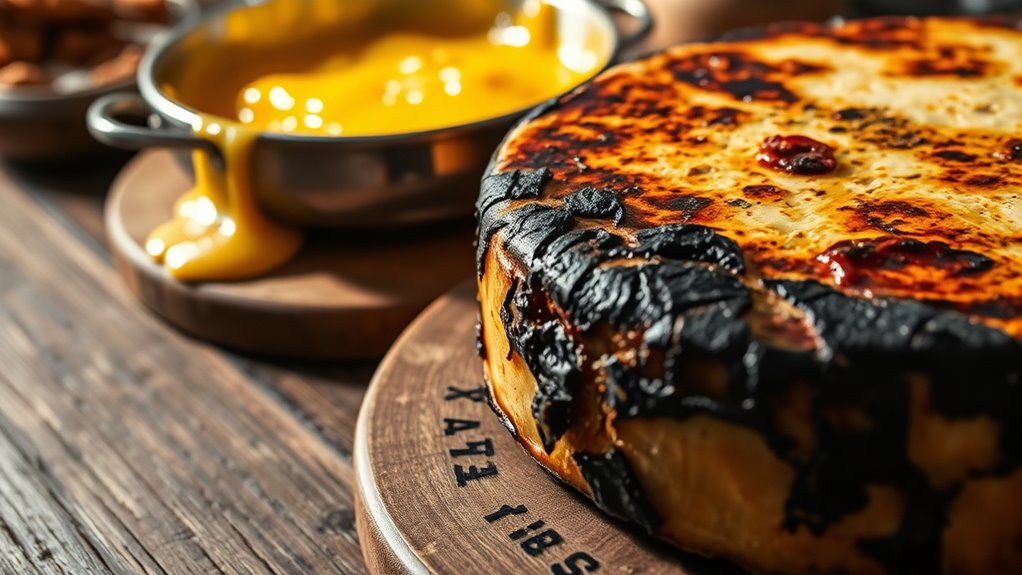
Have you ever wondered how to pick the perfect cheese for your meal or cheese board? One of the trickiest parts is avoiding cheese that burns or pools, which can ruin both the presentation and flavor. The key lies in understanding melting techniques and cheese flavor profiles, so you can select the right cheese for your culinary needs.
Different cheeses melt differently based on their moisture content, fat levels, and aging process. For example, high-moisture cheeses like mozzarella and young cheddar melt smoothly and evenly, making them ideal for fondue, grilled cheese, or topping dishes. These cheeses have a higher water content, which helps them melt without becoming greasy or stringy. On the other hand, hard cheeses like Parmesan or aged gouda have low moisture and tend to crumble or become oily when heated, often leading to burning or pooling if not handled carefully. Knowing these melting techniques helps you choose cheese that maintains its integrity under heat, avoiding the mess or burnt spots.
Your cheese flavor profiles also play a vital role in selecting the right cheese for cooking or serving. For instance, mild cheeses like mozzarella or young Swiss provide a neutral backdrop, perfect when you want the cheese to complement other ingredients without overpowering them. Conversely, sharper, more pungent cheeses like blue cheese or aged cheddar add bold flavor but require careful melting to prevent burning. When you’re heating cheese, it’s essential to pick varieties that will melt smoothly without developing a burnt taste or pooling unappetizingly. This means considering the fat content—higher fat cheeses tend to melt better and more evenly, reducing the risk of burning.
Another aspect to consider is temperature control. Lower and slow melting ensures your cheese doesn’t burn or pool. Using gentle heat and stirring frequently can help manage melting behavior, especially with cheeses prone to burning, like aged varieties. Additionally, combining cheeses with different melting properties can help achieve the desired consistency without risking over-melting or scorching. For example, mixing mozzarella with a touch of cream cheese can create a smoother, more stable melt that resists burning.
In essence, choosing the right cheese involves understanding its melting techniques and flavor profile. By selecting cheeses suited for your intended dish and managing heat carefully, you can prevent burning or pooling. Whether you’re making a delicate fondue, a cheesy sauce, or preparing a cheese-topped dish, knowing how different cheeses behave under heat ensures your meal turns out delicious, visually appealing, and free of unwanted melted mishaps.
Furthermore, proper heat management and understanding each cheese’s unique melting characteristics can significantly improve your culinary results and prevent common issues like burning or pooling.
Frequently Asked Questions
Which Cheeses Melt the Fastest?
You’ll find that soft cheeses like mozzarella, brie, and Camembert melt the fastest due to their high moisture content and lower melting temperatures. Their smooth, creamy textures make them ideal for melting quickly in dishes like pizza or fondu. Keep in mind, cheeses with firmer textures and higher melting temperatures, like cheddar or Swiss, melt more slowly. So, choose your cheese based on how quickly you want it to melt and its texture.
Can I Use Low-Fat Cheese for Melting?
Think of low-fat cheese as the underdog in your culinary journey. Yes, you can use it for melting, but keep in mind that it might not melt as smoothly or evenly as full-fat options. It’s great if you have dietary restrictions, offering fewer calories and fat. However, expect subtle flavor variations and potentially less creamy texture, so choose carefully based on your dish’s needs for the best results.
How to Prevent Cheese From Burning?
To prevent cheese from burning, keep it at low heat and stir constantly. Proper cheese storage guarantees freshness and prevents uneven melting. Be mindful of cheese flavor profiles; some cheeses melt better than others, like mozzarella or cheddar. Using a double boiler can help distribute heat evenly, reducing the risk of burning. Always melt cheese slowly, and avoid high heat, especially with delicate or aged varieties.
Are There Vegan Cheese Options That Melt Well?
Yes, there are vegan cheese options that melt well. Plant-based alternatives like cashew-based cheese, coconut oil blends, and commercial vegan cheeses are designed for good meltability, making them suitable for melting dishes. While their meltability comparison varies, many brands now focus on improving texture and melt quality. You can experiment with different brands to find one that melts just as well as traditional cheese, ensuring your dishes turn out delicious.
What’s the Best Way to Reheat Melted Cheese?
Ever find melted cheese cooling before you get to enjoy it? To reheat cheese smoothly, use gentle reheating techniques like low heat on the stovetop or in a double boiler. Keep cheese stored properly in airtight containers to prevent drying out, and stir frequently during reheating. This way, you preserve its creamy texture and flavor, making your leftovers just as delightful as when first melted.
Conclusion
Just like Icarus soared too close to the sun, you’ll avoid fiery mishaps by selecting the right cheese. Whether you’re melting, baking, or enjoying raw, remember that each cheese has its own destiny—some burn easily, others melt beautifully. Embrace the wisdom of the culinary gods and choose wisely. With this knowledge, you’ll craft dishes that shine instead of burn, turning every meal into a mythic feast. Now go, conquer your cheese adventures!

